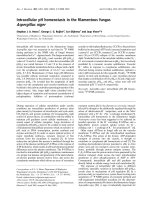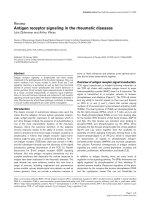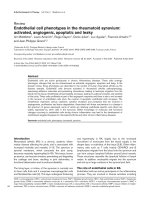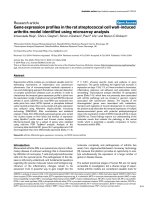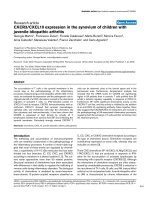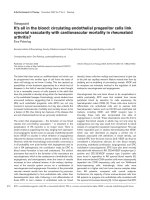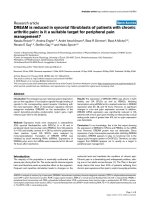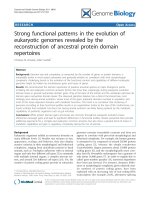Báo cáo y học: "Roundtable debate: Controversies in the management of the septic patient – desperately seeking consensus" ppsx
Bạn đang xem bản rút gọn của tài liệu. Xem và tải ngay bản đầy đủ của tài liệu tại đây (302.51 KB, 10 trang )
1
ACTH = adrenocorticotropic hormone; CAP = community-acquired pneumonia; CVP = central venous pressure; DIC = disseminated intravascular
coagulation; ED = emergency department; FiO
2
= fractional inspired oxygen; ICU = intensive care unit; MAP = mean arterial pressure; PA =
pulmonary artery; PCO
2
= partial carbon dioxide tension; PO
2
= partial oxygen tension; scVO
2
= central venous oxygenation.
Available online />Introduction
Despite continuous advances in technologic and
pharmacologic management, the mortality rate from septic
shock remains high. Each year in the USA there are an
estimated 400,000 cases of sepsis, resulting in more than
100,000 deaths annually [1]. The hemodynamic
derangements of septic shock are characterized by arterial
hypotension, peripheral vasodilatation, hypovolemia from
capillary leakage, and the development of myocardial
depression. An excessive inflammatory response typifies the
initial stages of infection and contributes to the progression
to organ failure. Progression to septic shock represents
failure of the circulatory system to maintain adequate delivery
of oxygen and other nutrients to tissues, causing cellular and
then organ dysfunction (Task force of the American College
of Critical Care Medicine and Society of Critical Care
Medicine [2]). The ultimate goals of therapy for shock are to
restore effective tissue perfusion, to normalize cellular
metabolism, and to preserve and restore tissue function.
Care of patients with sepsis includes measures to support
the circulatory system and treat the underlying infection.
Commentary
Roundtable debate: Controversies in the management of the
septic patient – desperately seeking consensus
Aaron B Waxman
1
, Nicholas Ward
2
, Taylor Thompson
1
, Craig M Lilly
3
, Alan Lisbon
4
, Nicholas Hill
5
,
Stanley A Nasraway
6
, Stephen Heard
7
, Howard Corwin
8
and Mitchell Levy
9
1
Pulmonary Critical Care Unit, Massachusetts General Hospital, Harvard Medical School, Boston, Massachusetts, USA
2
Pulmonary and Critical Care Medicine, Rhode Island Hospital, Brown University School of Medicine, Providence, Rhode Island, USA
3
Pulmonary and Critical Care Medicine, Brigham and Women’s Hospital, Harvard Medical School, Boston, Massachusetts, USA
4
Department of Anesthesia and Critical Care, Beth Israel Deaconess Medical Center, Harvard Medical School, Boston, Massachusetts, USA
5
Division of Pulmonary Critical Care, New England Medical Center, Tufts University School of Medicine, Boston, Massachusetts, USA
6
Surgical Critical Care, New England Medical Center, Tufts University School of Medicine, Boston, Massachusetts, USA
7
Department of Anesthesiology, University of Massachusetts Memorial Medical Center, University of Massachusetts Medical School, Worcester,
Massachusetts, USA
8
Pulmonary and Critical Care Medicine, Dartmouth-Hitchcock Medical Center, Dartmouth Medical School, Lebanon, New Hampshire, USA
9
Critical Care Medicine and Anesthesiology, Rhode Island Hospital, Brown University School of Medicine, Providence, Rhode Island, USA
Corresponding author: Aaron B Waxman,
Published online: 20 August 2004 Critical Care 2005, 9:E1 (DOI 10.1186/cc2940)
This article is online at />© 2004 BioMed Central Ltd
Abstract
Despite continuous advances in technologic and pharmacologic management, the mortality rate from
septic shock remains high. Care of patients with sepsis includes measures to support the circulatory
system and treat the underlying infection. There is a substantial body of knowledge indicating that fluid
resuscitation, vasopressors, and antibiotics accomplish these goals. Recent clinical trials have provided
new information on the addition of individual adjuvant therapies. Consensus on how current therapies
should be prescribed is lacking. We present the reasoning and preferences of a group of intensivists
who met to discuss the management of an actual case. The focus is on management, with emphasis on
the criteria by which treatment decisions are made. It is clear from the discussion that there are areas
where there is agreement and areas where opinions diverge. This presentation is intended to show how
experienced intensivists apply clinical science to their practice of critical care medicine.
Keywords sepsis, septic shock, resuscitation, pneumonia
2
Critical Care February 2005 Vol 9 No 1 Waxman et al.
Although there is a substantial body of knowledge indicating
that fluid resuscitation, vasopressors, and antibiotics
accomplish these goals, consensus on how they should be
prescribed is lacking. Recent clinical trials have provided new
information on the addition of individual adjuvant therapies,
including adrenal supplementation therapy, tight glucose
control, and drotrecogin alpha (activated) to standard
therapies. These therapies are effective with statistical
certainty in their respective study populations, but they do
not provide insights into potential synergistic or antagonistic
interactions, making it challenging to determine which
combination of treatments, if any, is best for a given patient. It
is the reasoning that clinicians use to process this
information and synthesize individual care plans that is the
focus of this commentary.
We present the reasoning and preferences of a group of
intensivists who met to discuss the management of an actual
case. Throughout this presentation, the focus is on
management, with emphasis on the points of discussion of
the criteria by which treatment decision are made. It is clear
from the discussion that there are areas where there is
agreement and areas where opinions diverge. Participants
support their opinions with literature citations and provide a
perspective on how clinical practice can be distinct from
participation in a clinical trial.
Case presentation part 1
The patient is a 56-year-old male who awoke the morning of
admission with nausea, shortness of breath, and diaphoresis.
Over the previous 2 days he had noted a productive cough,
associated with midline chest pain, shaking chills, and three
to four episodes of watery diarrhea. He had no abdominal
pain and no swelling or pain in the legs. Over the past
3 months he had lost 30 lb (approximately 13.6 kg) in weight
and he had recently sought medical attention for left shoulder
pain. A bone scan was reportedly negative. He had no known
drug allergies and took no medications. Family history was
unremarkable. He was a former smoker, of less than 20 pack-
years, having stopped about 3 years previously, and he
denied alcohol or illicit drug use. He had worked as a dry
cleaner for the past 30 years.
Physical examination in the emergency department (ED)
revealed a temperature of 97°F (36.1°C), a heart rate of
180 beats/min, and blood pressure of 120/60 mmHg. His
respirations were labored at 26 breaths/min, and oxygen
saturation was 89% on 4 l nasal cannulae oxygen. During the
examination he had an episode of coffee ground emesis. He
was put on a nonrebreather mask, and his oxygen saturation
increased to 98%. Breath sounds were diminished in the
right upper lung zones. His stool was hemoccult positive.
Initial laboratory study findings are summarized in Table 1.
Dr A As we stand at the bedside, reviewing the admission
laboratory findings and waiting impatiently for a chest
radiograph, let us try and put these findings together. First of
all, this patient presents with an acute illness with fever,
chills, a cough that is productive of purulent sputum, and
3 days of watery diarrhea. At first thought this sounds like
community-acquired pneumonia (CAP), possibly with an
atypical pathogen. Perhaps the diarrhea is a red herring.
Weight loss and left shoulder pain in a 53-year-old former
smoker raises concern for lung cancer with possible
postobstructive pneumonia, and we shall look for signs of
volume loss or chest wall metastasis on the chest radiograph.
This patient also has evidence of severe sepsis, with a left
shift, and tachycardia. He has signs of impending organ
failures with renal dysfunction, a creatinine level of 1.9 mg/dl,
metabolic acidosis, a coagulopathy with an elevated
prothrombin time and D-dimer, and low platelets that could
signal early disseminated intravascular coagulation (DIC). He
has respiratory failure, with an A–a gradient over 500. He is
probably hemoconcentrated, and clinically we would expect
him to be hypovolemic from diarrhea, high insensible losses,
and poor oral intake. My immediate therapeutic concern is
the tachycardia, the nature of the cardiac rhythm, and the
possibility of myocardial ischemia.
Dr D I might disagree with you that this patient has severe
sepsis. What if, after 2 or 3 l saline, his blood pressure, heart
Table 1
Initial laboratory values
Parameter Value
Potassium 3.5 mmol/l
Chloride 99 mmol/l
Carbon dioxide 19.9 mmol/l
BUN 26 mg/dl
Creatinine 1.9 mg/dl
Glucose 89 mg/dl
Hematocrit 43.7%
Platelet count 137,000 mm
3
Bands 18%
PT/INR 14.8 s/1.4
PTT 48.9 s
D-dimer >1000 ng/ml
PH 7.32
P
O
2
101 mmHg
P
CO
2
27 mmHg
ECG Narrow complex tachycardia with
2–3 mm ST-segment depressions in
leads V
3
–V
5
BUN, blood urea nitrogen; INR, international normalized ratio; PCO
2
,
partial carbon dioxide tension; PO
2
, partial oxygen tension; PT,
prothrombin time; PTT, partial thromboplastin time.
3
rate, and creatinine normalize? I think this illustrates one of the
greatest triage challenges in this area, and that is
differentiating infection with sepsis from another very common
scenario – infection with dehydration and hypovolemia. I think
the most important point is not to confuse sepsis with
hypovolemia from any cause, including hemorrhage.
Dr B The firsts steps in the care of patients like this should
be very systematic. Once the tachycardia was assessed and
assuming the chest readiograph confirms pneumonia, I would
initiate prompt antibiotic therapy based on the most likely
type(s) of infection; ensure adequate hemodynamic and
respiratory support; try to identify the source of infection;
identify and ascertain the extent of his organ dysfunction;
and, based on that, develop an overall treatment plan.
Dr C I agree – we need to treat this suspected infection.
Although a chest radiograph is not initially available, there is a
strong clinical suspicion for pneumonia, as a source of major
infection, and empiric antibiotic coverage should be started.
When the differential diagnosis includes a central nervous
system infection, there is never a question in regard to early
antibiotic coverage, and in fact antibiotics are started within a
window of 6–8 hours. Data for most infections, especially
pneumonia, have the same window of opportunity in regard
to mortality. Animal models of septic shock also indicate that
mortality can directly relate to time delay in antibiotics. If there
is any delay in the work up, including a delay in obtaining a
chest radiograph, then empiric treatment for CAP with
ceftriaxone and azithromycin should be initiated.
Case presentation part 2
The patient was given 2 l of normal saline and a chest
radiograph was obtained. He was given a total of 18 mg
adenosine with no response; and then 2.5 mg intravenous
verapamil in three doses, with a decrease in heart rate to
110 beats/min. Atrial fibrillation was diagnosed. His blood
pressure fell with these interventions. The chest radiograph
showed a dense opacity in the right-upper lobe with patchy
opacities in the right-lower lobe, the lingula, and left-upper
lobe. There were no clear air bronchograms or lateral shift to
suggest lobar collapse (Fig. 1).
Dr B There are now additional diagnostic data available, and
clinically important interventions have been done that raise
important considerations. The additional radiographic
information addresses the concerns raised about the 30 lb
weight loss and any chronic process that may be acutely
infected. There is no clear evidence of an endobronchial
lesion or airway obstruction. This, along with the history of a
recent negative bone scan, makes cancer less likely. Active
tuberculosis is possible, and sputum should be sent for
appropriate studies. With the complaint of midsternal
pleuritic chest pain, there is concern of pericardial
involvement. However, there are no suggestive changes on
the ECG, and the heart size looks normal, somewhat narrow,
and probably under-filled, which is consistent with
hypovolemia.
Dr A Do we need to consider any other diagnostic tests for
CAP in a patient with severe sepsis?
Dr C It can be very helpful in cases like this to have blood
and sputum cultures. It is usually possible to get a set of
blood cultures in patients like this, prior to starting antibiotics.
Although they do not have a high yield, they can play an
important role in the treatment of the infection by identifying
possible sources and unusual or resistant organisms. They
can also help to identify high-risk patients.
Dr B The purist’s goal is to try to establish a bacteriologic
diagnosis, but the realization is that one must initially treat
broadly because no single test has the sensitivity and
specificity to allow one to treat narrowly. Regardless, the
coverage we use includes coverage for almost every possible
bacteriologic pathogen. Knowing that this patient is from the
community, we do not need to consider double Gram-
negative coverage, even in a septic patient. If a patient is
from the community but has recently been hospitalized, is
immunosuppressed, is being treated with steroids, or has
Available online />Figure 1
Initial radiograph showing a right-upper lobe opacity and opacities in
the right-lower, lingula, and left-upper lobes.
4
structural lung disease, such as bronchiectasis, then we
would consider alternative or additional antibiotic coverage to
cover for Pseudomonas spp. or other resistant Gram-
negative rods. For the time being there is no indication to
change either the azithromycin or ceftriaxone. I agree that to
try to obtain a bacteriologic diagnosis, we use blood, urine
and sputum cultures, if available, and might perform
bronchoscopy once the patient is hemodynamically stable.
Dr C Getting back to the ECG, the patient has a narrow
complex tachycardia with a rate of 190 beats/min with
2–3 mm ST-segment depressions across the precordium.
Should the heart rate be directly controlled? Could the
patient be having a myocardial infarction or is he simply
volume depleted? I am concerned about using adenosine
before adequately addressing the patient’s volume status.
The initial approach should be to volume replete him
aggressively and see whether the hemodynamics improve,
and then address any persistent tachycardia only after he is
volume replete. In this case, rate controlling agents may not
be the first line of therapy, given a strong suspicion for
sepsis. One question that comes up is, what if he is ischemic
and you start volume resuscitating him? Is he going to go
into heart failure? Does that matter? This should not be an
issue. If the need arises then support him with invasive or
noninvasive ventilation and get him through this. Regardless
of the cause of the tachycardia, fluid load this patient.
Dr A Would there be any indication to treat him for an acute
coronary syndrome with aspirin or heparin at this point?
Would there be a problem with starting heparin in this man if
one felt he truly had a coronary basis of ischemia versus
demand ischemia? It is likely that this represents demand
related ischemia, as opposed to an unstable coronary
syndrome. This is a 55-year-old man. The ECG shows a
narrow complex tachycardia at 190 beats/min with ST-
segment depressions in V
3
–V
5
. Creatine phosphokinase and
troponin levels were all initially normal. Is there a down side
to giving aspirin? Aspirin is not going to be of much value, if
you think this is demand-related ischemia. It does complicate
the decision making for drotrecogin alpha (activated) should
he develop severe sepsis. There is also the concern that he
is having gastrointestinal bleeding. There is reluctance to go
after his ischemia in a big way until we get his rate controlled.
If ECG changes persist after control of heart rate, then we
might consider aspirin. If heparin is started then it can easily
be discontinued.
Dr B I agree that aspirin may complicate the decision making,
should you want to give a new agent like drotrecogin alpha
(activated). Patients receiving aspirin or other antiplatelet
agents were excluded from the PROWESS (Recombinant
Human Activated Protein C Worldwide Evaluation in Severe
Sepsis) trial, and so its safety in the presence of antiplatelet
agents is unclear. If you think the patient is more at risk for
death from severe sepsis than from demand ischemia, then
your attention should be directed toward the interventions
that are most likely to give the patient benefit. Because this
patient had no prior history of coronary disease, and because
demand related ischemia is more likely than an acute
coronary syndrome that may benefit from aspirin, the
risk/benefit moves one step toward sepsis interventions
rather than acute myocardial infarction interventions.
Coronary flow is upregulated in sepsis [3–5]. It is actually
unusual for patients to develop myocardial ischemia.
Case presentation part 3
The patient was admitted to the general medical floor. He
was still tachycardic at 110 beats/min in sinus rhythm, and
ST-segment changes had resolved. He was described as
being cold and clammy. His systolic blood pressure was now
in the 90s. He was given an additional 3 l normal saline,
resulting in a blood pressure of 110/60 mmHg. He was
increasingly tired, and his breathing became more labored.
He received ceftriaxone and azithromycin. The patient
subsequently required orotracheal intubation with a #8
endotracheal tube. He was given fentanyl, propofol, and
midazolam for intubation. Eight hours after presenting in the
ED, he was transferred to the intensive care unit (ICU). A
chest radiograph following intubation showed progression of
the right-upper lobe process. The heart rate was
106 beats/min, and blood pressure was 94/47 mmHg with a
mean arterial pressure (MAP) of 60 mmHg. Oxygen
saturations were 96% on 100% oxygen. An additional 3 l
normal saline was given, for a total of about 6.5 l (Fig. 2).
Dr A What is interesting in this case is that, in the ED, when
you have someone who already has single organ failure and
some borderline findings that make you suspect he is on his
way to multiorgan failure, should this patient automatically be
an ICU admission? We argue this frequently because, if you
volume resuscitate this patient in the ED and he turns around
in the ED, the tachycardia goes away, the ST segments
normalize, his respiratory distress gets better, and he either
goes to an ICU or a regular floor bed. This becomes a very
important triage question. This patient is a great example of
someone who has the potential to crash very hard, and if you
intervene right away with early therapy you may be able to
reverse at least what we see as early organ dysfunction and
prevent multiorgan failure. This man could have gone straight
to the ICU, and we could have figured all this out there,
rather than try to get him floor ready. The other thing is that if
you send him to the ICU, he could spend 24 hours there and
then be ready to go to the floor; instead he ended up coming
to the ICU for a week.
Case presentation part 4
Two hours later, the patient was agitated on the ventilator
and had frequent high peak airway pressure alarms; the
oxygen saturations were stable. The blood pressure had
been trending downward, with systolic in the high 70s, MAP
in the 50s, and urine output under 20 cc/hour. His sodium
Critical Care February 2005 Vol 9 No 1 Waxman et al.
5
was 137 mmol/l, potassium 3.2 mmol/l, chloride 118 mmol/l,
carbon dioxide 17.8 mmol/l, blood urea nitrogen 18 mg/dl,
and creatinine 1.1 mg/dl, the latter representing an
improvement. The glucose was 170 mg/dl, phosphate was
down to 1.4 mg/dl, and albumin was 1.3 g/dl. The white cell
count was 6500/mm
3
with 15% bands; platelets were
56,000/mm
3
. The hematocrit was down to 28.4%. Cardiac
enzymes were within normal limits. The arterial blood gases
on 50% inspired fractional oxygen (Fi
O
2
) were as follows:
pH 7.46, partial carbon dioxide tension (P
CO
2
) 24 mmHg,
and partial oxygen tension (P
O
2
) 99 mmHg. Central venous
pressure (CVP) was 14 cmH
2
O. Central venous PO
2
was
39 mmHg. Lactate was 5.6 mg/dl. Norepinephrine
(noradrenaline) was being started (Fig. 3).
Dr D Resuscitation is clearly ongoing, and appropriate end-
points have not yet been reached. The patient is hypotensive,
in spite of 8–10 l crystalloid. He has not received any blood,
and pressors are being started. He was just intubated and
heavily sedated. The chest radiograph needs to be checked
for anything that could have a negative hemodynamic impact,
such as a pneumothorax or other mechanical reasons for
shock.
Dr A How do we judge the completeness of his volume
resuscitation?
Dr B Clinical indices should be the first guide to the
appropriateness of volume resuscitation. Clinical markers that
were originally deranged can be followed, looking for
improvement. Regardless, many of these patients may go on
to develop organ failure. A threshold is often reached at
which volume is given to the point that the presumption is
that the patient is intravascularly replete. How is that point
defined in the patient with organ failure? It depends, in part,
on the age of the patient and cardiac function. If the patient is
young or left ventricular function is known from a previous
echocardiogram, then a central venous line with CVP and
central venous oxygenation (scV
O
2
) monitoring may be
adequate. Alternatively, if cardiac function is not known or
there is a suspicion of compromise, especially in an elderly
patient, or if a large volume of fluid has been given without
improvement, then invasive monitoring with a pulmonary
artery (PA) line would be a consideration. When do you
decide that enough fluid has been given? When is it time to
hang a pressor or an inotrope? Initial volume resuscitation
should be between 8 and 10 l, but after that how do you
decide if that is enough or if are they leaking into the third
space?
Dr A Adequacy of volume resuscitation is a big picture issue,
and I never rely on a single variable. Multiple parameters are
considered, including the hemodynamic measurements of
heart rate, blood pressure, urine output, skin perfusion, and
mentation. If these measures do not improve with aggressive
volume expansion, then a PA line is considered. This
suggests that it takes an experienced intensivist to judge fluid
requirements. How does the resident or nonintensivist do it?
As part of the protocol for early goal-directed therapy,
pressors are used to keep the MAP about 60 or the systolic
Available online />Figure 2
Postinstubation radiograph showing progression of the right-upper
lobe opacity.
Figure 3
Radiograph showing progressive involvement of both lungs.
6
pressure above 90. Fluids are given to raise the CVP to
between 10 and 12. The central venous oxygen saturation is
pushed up with dobutamine and/or red cells. If these goals
are not achieved within a reasonable time frame, then
consider what additional information can be obtained from
the PA catheter. The reason why the PA catheter trials have
been so inconclusive is because there have been such
varying goals or protocols associated with their use. If we
could figure out the best protocol to resuscitate people, then
we might be able to use the PA line as a guide and perhaps
show benefit over non-PA-guided protocols.
Dr D This raises the question as to when pressors should be
started. The preference is not to hang vasopressors early in
the resuscitation. If the patient is not adequately volume
resuscitated, then splanchnic blood flow could be
compromised by pressors. Conversely, we cannot allow a
patient to remain hypotensive while striving to achieve volume
resuscitation goals. Although the preference is to refrain from
giving vasopressors before adequate volume resuscitation,
sometimes we have to maintain an adequate blood pressure.
In patients who are on pressors, should target goals be
adjusted? It is likely that a higher central venous pressure is
required in patients who are on pressors. A patient who has a
CVP of 12 or 15, but who requires significant doses of
vasopressors to maintain adequate MAP, might really need a
CVP of 25.
Dr B When resuscitating a septic patient, there is a need, if
we have not achieved our therapeutic goal, to double check
the status of the left ventricle. We should not make an
assumption in the septic patient that left ventricular function
is normal. Many of these patients, perhaps even this one,
have pulmonary vascular alterations in which there is a
disconnect between the left and right side. They can have
elevated CVPs in the presence of a low wedge. In this
setting the PA catheter may give us additional useful
information that CVP does not. An important point is not to
fall into the trap of searching for the one best number. There
is no one best number. Generally, there is a lot of information
being generated for each patient, and it is important to look
at all this information, especially the stroke volume or cardiac
output for given CVP or wedge values, and how all these
variables change, or do not change, after fluid boluses.
Noninvasive estimates of preload and cardiac function can
also be obtained. We all want to be reassured that we have
given enough, but not too much, volume. If more fluid is
given, and whatever index of cardiac function is being
followed does not change, then we’re probably close to
adequate fluid resuscitation. That said, we have no idea
whether this is the right construct, even though we all seem
to agree on it. It may be that a strategy that favors
norepinephrine, vasopressin, and/or inotropes allowing for
less fluid resuscitation produces better outcomes than one
that favors aggressive fluid resuscitation aimed at optimizing
cardiac output and minimizing vasopressors. One recent
study of elective surgical patients [6] showed superior
outcomes with a severely restricted perioperative fluid
management strategy. We need much better studies in this
area.
Case presentation part 5
He received over 10 l isotonic crystalloid, and his initial CVP
was around 6 mmHg. He received additional volume as a
combination of crystalloid and colloid; the resulting CVP was
15 mmHg.
Dr A Is it possible to be more efficient in the resuscitation?
Do colloids make a difference in resuscitation?
Dr D Colloids make a difference in the sense that we can
volume resuscitate much more quickly. We also add oncotic
pressure, which hopefully keeps more crystalloid
intravascularly, and the total volume of fluid is less. If the
issue is one of timing, then the more aggressively you
achieve your end-diastolic volume goals, the better.
Dr C Inadequate preload in sepsis and septic shock is
multifactorial and can be related to venodilation, fever and
fluid losses, and diffuse capillary leak. Vascular dysfunction
presumably results from damage to underlying endothelium
and likely results in compromised endothelial barrier function.
Larger colloids are more likely to stay in the intravascular
space. This, in combination with widespread inflammatory
activation, explains one of the challenges of fluid therapy –
capillary leak and formation of edema. This also plays a role in
the requirement for large volume resuscitation. Restoration of
adequate circulatory volume is necessary to permit adequate
tissue perfusion, but it may not be sufficient on its own to
correct microvascular abnormalities associated with sepsis.
Dr A The literature does not support a benefit of one colloid
over the other, or colloids over crystalloids. So the question
is, you know you can give 10 l crystalloid or you can give 2.5 l
colloid, so why wouldn’t you just give 2.5 l? It is faster, with
the same gauge intravenous line. Many intensivists would
generally use 100% crystalloid, and many of us would look
for reasons to give blood. If the hemoglobin is below 10, then
packed red blood cells would be reasonable.
Dr B For the most part I would use crystalloid as a first-line
agent. Some of us would consider using both starch and
blood, depending on the hemoglobin. As far as a specific
approach, once I have reached a point where the patient has
received over 6–10 l crystalloid, there is a desire to give
something that is going to stay intravascular and provide
more volume expansion with less total volume. At this point, I
would start using colloid and, especially knowing his
hemoglobin is where it is, I would probably give him starch.
The bottom line is that most of us agree that the quantity and
timing of whatever you pick is much more important than the
fluid you pick.
Critical Care February 2005 Vol 9 No 1 Waxman et al.
7
Dr A Would anybody transfuse this patient with a hematocrit
of 28.4?
Dr C Knowing he has a hematocrit that was 43 when he
came in is important. He has had close to 10 l of crystalloid.
Based on the protocol of Rivers and coworkers [7], initial
volume resuscitation was given to get the CVP to 8–12.
scV
O
2
is then examined. If the scVO
2
is under 70, then either
dobutamine or red cells (to get to a hematocrit of 30) are
given to achieve a scV
O
2
above 70%. It is not entirely clear
why the patients assigned to early goal-directed therapy in
the Rivers study did better. The data suggest that it was not
necessarily because they got blood but rather the timing of
how much fluid they received. At the end of 72 hours, both
groups received the same amount of fluid but it was
frontloaded in the early goal-directed therapy group,
potentially having only to do with the aggressiveness of
resuscitation. However, the protocol group did receive more
blood (64% versus 16% transfused) during the first 6 hours.
Dr B There are several studies that show that packed red
blood cells may not increase oxygen utilization in sepsis. It is
believed their main benefit in a situation like this is as a
colloid — one that is very expensive, is of limited supply, and
may have a variety of infection risks.
Dr A Should we treat this patient with empiric steroids?
Dr D The best current evidence with which to answer this
question comes from the randomized controlled trial
conducted by Annane and coworkers [8]. A prior trial
suggested that failure to augment serum cortisol by 9 µg/dl
after high-dose adrenocorticotropic hormone (ACTH) was a
bad prognostic sign and was independent of the pre-ACTH
stimulated cortisol value [9]. The subsequent randomized
controlled trial by Annane and coworkers showed benefit
from steroids in the ACTH nonresponder patients only.
Therefore, a random cortisol without cosyntropin may not
help you decide whether to treat relative adrenal
insufficiency. On the practical side, in many institutions
cortisol results are not available for 2 days. If that were the
case, then I would draw a pre- and post-ACTH cortisol and
begin hydrocortisone 50 mg every 6 hours until the cortisol
results return. I think we all would withdraw steroids if the
serum cortisol increased by more than 9 µg/dl following
ACTH.
Dr A According to the study by Annane and coworkers [8], if
the baseline cortisol goes from 55 to 61, then the patient
must be treated because they have relative adrenal
insufficiency. An argument could be made that if the baseline
cortisol is 55, then the patient may not benefit from additional
steroids. Of the 299 patients who were studied and the 229
who were said to be adrenally insufficient, we do not know
what fraction of those patients truly had a baseline cortisol of
55. In the patients who had an elevated cortisol to start with,
it is unclear whether there is really any benefit in steroid
replacement.
Dr D A cosyntropin stimulation test is easy and safe and is
the only clear way, at the present time, to distinguish patients
who appear to have an insufficient adrenal response.
Because the random cortisol is not a reliable index, the best
approach would be to treat the patient with steroid
replacement therapy, pending the results of the cosyntropin
stimulation test, and withdraw steroids, once those results
show a normal response. This assumes that patients who
respond are not harmed by 2 days of steroids.
Case presentation part 6
Two hours later the sodium was 135 mmol/l, potassium
4.5 mmol/l, chloride 94 mmol/l, carbon dioxide 17 mmol/l,
blood urea nitrogen 21 mg/dl, creatinine 1.8 mg/dl, and
glucose 153 mg/dl. An arterial blood gas on 60% Fi
O
2
revealed pH 7.33, PCO
2
34 mmHg, and PO
2
70 mmHg, with
a central venous oxygen saturation of 66%. The white blood
cell count was 32,000/mm
3
with 32% bands. The platelets
had dropped to 28,000/mm
3
, and the international
normalized ratio was 1.8, with a prothrombin time of 19.5 s
and a partial thromboplastin time of 50 s. Urine output had
increased to 40 cc/hour.
Dr A Should this patient be treated with drotrecogin alpha
(activated)?
Dr B This patient has septic shock, organ injury,
coagulopathy, and signs of DIC. His platelets are 28,000,
which is below the 30,000 cutoff used in the PROWESS
trial [10], but I think this may be exactly the kind of patient
who should receive Drotrecogin alpha (activated). In the
PROWESS trial DIC was part of the enrollment criteria.
Actually, in the subgroup analysis, the DIC patients did
better. If there is concern with the platelet count, we can
either give platelets if this man had a lot of incisions or
previously showed bleeding or forget about the platelet
count, give the drotrecogin alpha (activated), and watch him
expectantly.
Dr D My understanding of the mechanisms by which this
drug works tells me that drotrecogin alpha (activated) works
by reversing the underlying pathophysiology in sepsis, and if
you can improve this patient rapidly in the first 24 hours with
standard therapies, then he is likely to have a better mortality.
If you can’t, then an intervention with a drug like drotrecogin
alpha (activated) makes sense [11]. The data make a case
for early treatment in all respects. Early intervention of almost
anything is better than later intervention. Given what we know
of the sepsis cascade, the further it rolls on the worse it gets.
For most of us who have been sepsis investigators for a long
time, the generalized expectation is that the earlier we
intervene the better the chances that one can interrupt the
sepsis cascade, and so on.
Available online />8
Case presentation part 7
Over the next 48 hours the findings on chest radiography
improved. A chest computed tomography scan was done
and did not reveal an endobronchial lesion. By day 3 the
patient was off pressors. Urine output was up and the Fi
O
2
is
down. The patient was awake, alert, and responsive. On the
third hospital day he was extubated. The white count was
14,000/mm
3
without bands. The platelets and prothrombin
time normalized, and the creatinine was normalizing (Fig. 4).
Dr A The next question is whether he is clearly getting better.
Do we keep the patient in the ICU to complete the full course
of drotrecogin alpha (activated) or send him to the floor?
Those are two different questions: do we have to complete the
full 96-hour infusion and do we keep a patient who no longer
requires ICU level care in the unit to complete the treatment?
Dr D Here is a man who is off the vent; renal failure and
hypotension are resolved. If someone meets every other
criterion for leaving the ICU – except for the fact they are
receiving drotrecogin alpha (activated) – do you send him out
of the ICU on drotrecogin alpha (activated) or stop the
infusion early to send him out to the medical floor? If he is
this stable, then I would stop the infusion and send him out. I
think most would agree that you wouldn’t keep the patient in
the ICU solely to keep him on drotrecogin alfa (activated) if
he is no longer critically ill. However, the much more common
question is if he were still intubated, off pressors, looking
much better, and one was thinking about extubating,
72 hours into the course, would one continue drotrecogin
alpha (activated)? In that case I feel compelled to continue
the drug. We don’t raise that same question with antibiotics,
and in that scenario he would continue to receive antibiotics
for the next 7–10 days.
Summary
The analysis and commentary of the care provided to this
patient with severe sepsis and septic shock highlight the
challenges in assessing and managing critically ill patients.
The participants provided their perspectives on the
recognition of physiological instability and the definition of
severe sepsis and septic shock; at what point a patient
should be admitted to the ICU; the importance of early goal-
directed resuscitation therapy and the choice of resuscitation
fluid; when to consider intravascular monitoring; the use of
low-dose corticosteroids and drotrecogin-alpha; and at what
point an improving patient should leave the ICU (Table 2).
In this case, the assessment of the patient begins with
recognition of the signs and symptoms of a serious infection.
The participants agreed not only that antibiotic treatment
should be given within 8 hours of presentation but also that
combination therapy for CAP was appropriate. It was agreed
that cultures of blood, urine, and sputum are indicated but
should not delay the initiation of antibiotic therapy. Diagnostic
bronchoscopy was not recommended while the patient was
hemodynamically unstable.
Patients often present with tachycardia and
electrocardiographic abnormalities that may reflect sepsis,
infection with vasodilation and hypovolemia (so-called
ineffective arterial circulation), or cardiac ischemia.
Distinguishing sepsis and an ineffective circulation from an
acute coronary syndrome can be challenging. All of the
participants agreed that, regardless, the most important effort
should be directed toward restoring adequate intravascular
volume. Resolution of tachycardia and increased urine flow
with fluid resuscitation would suggest that hypovolemia and
sepsis were the problems. Although there were differences
of opinion regarding the timing of CVP or PA catheter
placement, all were in agreement that a CVP or pulmonary
capillary wedge pressure in the single digits was
inappropriate for this patient. Furthermore, all agreed that the
adequacy of volume resuscitation was best determined from
cumulative data, including serial hemodynamic
measurements, measurements of arterial and central venous
oxygenation, and the response to volume infusion.
Both the availability and potential risks (although small) of
transfusion of red blood cells made their use more restricted.
The group agreed that patients with a hematocrit of less than
30 and a mixed or central venous oxygen saturation of less
than 70% might benefit from red cell transfusion.
Additionally, everyone agreed that patients who are not likely
to be harmed by 2 days of steroid replacement with
hydrocortisone and fludrocortisone, but continued treatment
with steroids should be guided by the results of a
Critical Care February 2005 Vol 9 No 1 Waxman et al.
Figure 4
Radiograph showing generalized improvement.
9
Available online />Table 2
Summary of the views of the participants on alternative approaches to these therapeutic options for a man with circulatory failure in the context of a community-acquired
pneumonia
Would you manage this
patient with … Dr AW Dr NW Dr TT Dr CL Dr AL Dr ML Dr NH Dr SN Dr SH Dr HC
Early empiric antibiotics Agree Agree Agree Agree Agree Agree Agree Agree Agree Agree
(ceftriaxone and azithromycin)
Early volume resuscitation Agree Agree Agree Agree Agree Agree Agree Agree Agree Agree
Colloid Yes, in No No No Yes, in No No Yes, in Yes, in No
combination with combination with combination with combination
crystalloid crystalloid crystalloid with crystalloid
Crystalloid Agree Agree Agree Agree Agree Agree Agree Agree Lactated Ringers Agree
Packed red blood cells Agree Agree Agree Agree Agree Agree Agree Agree Agree No
Dobutamine Agree Agree Agree No Agree Agree Agree Agree Agree No
Empiric steroids Agree Agree Agree Agree Agree Agree Agree Agree Agree Agree
Cosyntropin test Agree Agree Agree Agree Agree Agree Agree Agree Agree Agree
DC steroids if cortisol Agree Agree Agree Agree Agree Agree Agree Agree Agree Agree
change >9
Line for CVP monitoring Agree Agree Agree Agree Agree Agree Agree Agree Agree Agree
PA Catheter If persistent If persistent If persistent If persistent No If persistent If persistent Agree No No
hypotension hypotension hypotension hypotension hypotension hypotension
and oliguria and oliguria and oliguria and oliguria and oliguria and oliguria
with CVP with CVP with CVP with CVP with CVP with CVP
>12 cmH
2
O >12 cmH
2
O >12 cmH
2
O >12 cmH
2
O >12 cmH
2
O >12 cmH
2
O
Drotrecogin alpha Agree Agree Agree Agree Agree Agree Agree Agree Agree Agree
(activated)
CVP, central venous pressure.
10
cosyntropin stimulation test. All of the participants agreed
that this patient with severe sepsis and no contraindications
should be treated with drotrecogin-alpha (activated).
Conclusion
The Blue Ginger Group has prepared this synthesis of
opinion on the optimal treatment of a specific case of severe
sepsis in order to share how experienced critical care
providers treat their patients. This presentation in not
intended to advocate particular treatment algorithms but
rather to show how experienced intensivists apply clinical
science to their practice of critical care medicine. Applying
information provided by clinical trials to practice requires
synthetic reasoning, judgment, and knowledge about the
patient as well as those patients included in the studies. Even
more important than the specific details of this analysis is that
we need more high-quality clinical trial data to clarify which
treatments or combinations of treatments best help individual
patients with severe sepsis.
Competing interests
The author(s) declare that they have no competing interests.
Acknowledgments
We want to extend our appreciation to Chef Ming Tsai, who has
allowed us to meet on a regular basis at his restaurant, The Blue
Ginger, in Wellesley, Massachusetts. This not only has stimulated our
ongoing efforts at improving critical care delivery but it also has
enhanced our individual gastronomic development.
We also acknowledge the administrative support provided by Barbara
Shott at The Rhode Island Hospital, without which none of this would
have ever happened.
The Blue Ginger Group includes Howard Corwin, MD; Stephen Heard,
MD; Nicholas Hill, MD; Mitchell Levy, MD; Craig M Lilly, MD; Alan
Lisbon, MD; Stanley A Nasraway, MD; Taylor Thompson, MD; Nicholas
Ward, MD; and Aaron B Waxman, MD, PhD.
References
1. Angus DC, Linde-Zwirble WT, Lidicker J, Clermont G, Carcillo J,
Pinsky MR: Epidemiology of severe sepsis in the United
States: analysis of incidence, outcome, and associated costs
of care. Crit Care Med 2001, 29:1303-1310.
2. Hollenberg SM, Aherns TS, Astiz ME, Chalfin DB, Dasta JF, Heard
SO, Martin C, Sulsa GM, Vincent JL Practice parameters for
hemodynamic support of sepsis in adult patients. Crit Care
Med 1999, 27:639-660.
3. Cunnion RE, Schaer GL, Parker MM, Natanson C, Parrillo JE: The
coronary circulation in human septic shock. Circulation 1986,
73:637-644.
4. Ellrodt AG, Riedinger MS, Kimchi A: Left ventricular perfor-
mance in septic shock: reversible segmental and global
abnormalities. Am Heart J 1985, 110:402-409.
5. Raper RF, Sibbald WJ, Hobson J, Neal A, Cheung H: Changes in
myocardial blood flow rates during hyperdynamic sepsis with
induced changes in arterial perfusing pressures and meta-
bolic need. Crit Care Med 1993, 21:1192-1199.
6. Brandstrup B, Tonnesen H, Beier-Holgersen R, Hjortso E, Ording H,
Lindorff-Larsen K, Rasmussen MS, Lanng C, Wallin L, The Danish
Study Group on Perioperative Fluid Therapy: Effects of intravenous
fluid restriction on postoperative complications: comparison of
two perioperative fluid regimens: a randomized assessor-
blinded multicenter trial. Ann Surg 2003, 238:641-648.
7. Rivers E, Nguyen B, Havstad S, Ressler J, Muzzin A, Knoblich B,
Peterson E, Tomlanovich M: Early goal-directed therapy in the
treatment of severe sepsis and septic shock. N Engl J Med
2001, 345:1368-1377.
8. Annane D, Sebille V, Charpentier C, Bollaert P-E, Francois B,
Korach J-M, Capellier G, Cohen Y, Azoulay E, Troche G, et al.:
Effect of treatment with low doses of hydrocortisone and flu-
drocortisone on mortality in patients with septic shock. JAMA
2002, 288:862-871.
9. Annane D, Sebille V, Troche G, Raphael JC, Gajdos P, Bellissant
E: A 3-level prognostic classification in septic shock based on
cortisol levels and cortisol response to corticotropin. JAMA
2000, 283:1038-1045.
10. Bernard GR, Vincent JL, Laterre PF, LaRosa SP, Dhainaut J-F,
Lopez-Rodriguez A, Steingrub JS, Garber GE, Helterbrand JD, Ely
EW, et al.: Efficacy and safety of recombinant human activated
protein C for severe sepsis. N Engl J Med 2001, 344:699-709.
11. Levy MM, Macias WL, Russell JA, Williams MD, Trzaskoma BL,
Silva E, Vincent J-L. Failure to improve during first day of
therapy is predictive of 28-day mortality in severe sepsis.
Chest 2003, 124:120S-123S.
Critical Care February 2005 Vol 9 No 1 Waxman et al.

